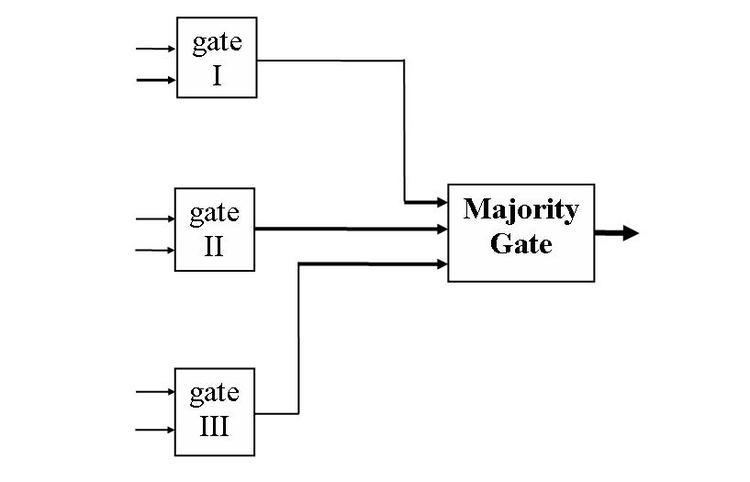 | ||
In computing, triple modular redundancy, sometimes called triple-mode redundancy, (TMR) is a fault-tolerant form of N-modular redundancy, in which three systems perform a process and that result is processed by a majority-voting system to produce a single output. If any one of the three systems fails, the other two systems can correct and mask the fault.
Contents
- Chronometers
- Majority Logic Gate
- TMR operation
- Voter
- Triple modular redundancy in popular culture
- References
The TMR concept can be applied to many forms of redundancy, such as software redundancy in the form of N-version programming, and is commonly found in fault-tolerant computer systems.
Some ECC memory uses triple modular redundancy hardware (rather than the more common Hamming code), because triple modular redundancy hardware is faster than Hamming error correction software. Space satellite systems often use TMR, although satellite RAM usually uses Hamming error correction.
Some communication systems use N-modular redundancy as a simple form of forward error correction. For example, 5-modular redundancy communication systems (such as FlexRay) use the majority of 5 samples – if any 2 of the 5 results are erroneous, the other 3 results can correct and mask the fault.
Modular redundancy is a basic concept, dating to antiquity, while the first use of TMR in a computer was the Czechoslovak computer SAPO, in the 1950s.
Chronometers
To use triple modular redundancy, a ship must have at least three chronometers; two chronometers provided dual modular redundancy, allowing a backup if one should cease to work, but not allowing any error correction if the two displayed a different time, since in case of contradiction between the two chronometers, it would be impossible to know which one was wrong (the error detection obtained would be the same of having only one chronometer and checking it periodically). Three chronometers provided triple modular redundancy, allowing error correction if one of the three was wrong, so the pilot would take the average of the two with closer reading (vote for average precision).
There is an old adage to this effect, stating: "Never go to sea with two chronometers; take one or three."
Mainly this means that if two chronometers contradict, how do you know which one is correct? At one time this observation or rule was an expensive one as the cost of three sufficiently accurate chronometers was more than the cost of many types of smaller merchant vessels. Some vessels carried more than three chronometers – for example, the HMS Beagle carried 22 chronometers.
In the modern era, ships at sea use GNSS navigation receivers (with GPS, GLONASS & WAAS etc. support) -- mostly running with WAAS or ENGOS support so as to provide accurate time (and location).
Majority Logic Gate
In TMR, three identical logic circuits (logic gates) are used to compute the same set of specified Boolean function. If there are no circuit failures, the outputs of the three circuits are identical. But due to circuit failures, the outputs of the three circuits may be different.
A Majority Logic Gate is used to decide which of the circuits’ outputs is the correct output. The majority gate output is 1 if two or more of the inputs of the majority gate are 1; output is 0 if two or more of the majority gate’s inputs are 0.
The Majority Logic Gate is a simple AND–OR circuit: if the inputs to the majority gate are denoted by x, y and z, then the output of the majority gate is
Thus, the majority gate is the carry output of a full adder, i.e., the majority gate is a voting machine.
TMR operation
Assuming the Boolean function computed by the three identical logic gates has value 1, then: (a) if no circuit has failed, all three circuits produce an output of value 1, and the majority gate output has value 1. (b) if one circuit fails and produces an output of 0, while the other two are working correctly and produce an output of 1, the majority gate output is 1, i.e., it still has the correct value. And similarly for the case when the Boolean function computed by the three identical circuits has value 0. Thus, the majority gate output is guaranteed to be correct as long as no more than one of the three identical logic circuits has failed.
TMR systems should use data scrubbing—rewrite flip-flops periodically—in order to avoid accumulation of errors.
Voter
The majority gate itself could fail. Is there a way to mask that failure? In other words, who guards the guardians?
In a few TMR systems, such as the Saturn Launch Vehicle Digital Computer and functional triple modular redundancy (FTMR) systems, the voters are also triplicated. Three voters are used – one for each copy of the next stage of TMR logic. In such systems there is no single point of failure.
However, in contrast to the relatively complicated Boolean functions computed in triplicate by the TMR system, the majority gate is a simple circuit, thus its probability of failure is significantly smaller than that of each of the three circuits computing the Boolean function. In other systems there is only a single voter—If the voter fails in such a system, then the complete system will fail. However, in a good TMR system the voter is much more reliable than the other TMR components.
